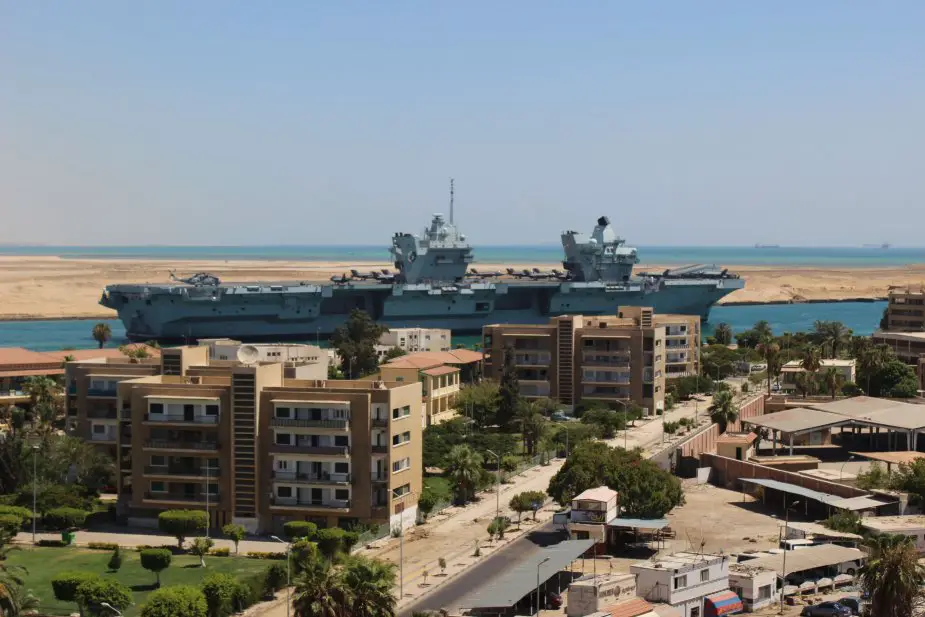According to information published by the government of the United Kingdom on July 19, 221, the Carrier Strike Group will undertake a series of exercises with forces from the US, Australia, France, Japan, New Zealand and Korea in the Philippine Sea in August.
Follow Navy Recognition on Google News at this link
 HMS Queen Elizabeth aircraft carrier (Picture source: Vayu Aerospace Review)
HMS Queen Elizabeth aircraft carrier (Picture source: Vayu Aerospace Review)
On a visit to US Indo-Pacific Command (INDOPACOM) in Hawaii, UK Defence Secretary Ben Wallace met with the Commander Admiral John C Aquilino and announced that the UK Carrier Strike Group will undertake a series of multinational exercises with global allies in the Philippine Sea this August.
Operating alongside Naval and Air Forces from the United States, Australia, France, Japan, New Zealand and the Republic of Korea, the UK Carrier Strike Group will undertake a number of integration exercises designed to build interoperability between like-minded international partners in this globally significant region of the world. The HMS Queen Elizabeth led Strike Group will operate with a US Carrier Strike Group, which combined, will be the largest concentration of F-35 jets anywhere in the world.
Complex exercises like these will enable 617 Squadron to develop F-35 Lightning interoperability with partner nations, building a core of valuable Royal Air Force and Royal Navy experience in operating this cutting-edge technology. These air exercises will build upon the capability development that 617 Squadron achieved through the combat missions mounted from the Carrier in the East Mediterranean, during a dedicated period in support of Operation Shader, the UK mission to defeat Daesh in Iraq and Syria.
The Carrier Strike Group will also undertake Anti-Submarine exercises with US Pacific Fleet with allied submarines, helicopters and P8 Maritime Patrol Aircraft.
Overall these events represent a crucial milestone in the regeneration of the UK Carrier Strike capability that will contribute to collective defence and security for decades to come. Carrier Strike Group 21 embodies the Prime Minister’s vision for the UK as an outward-facing, modern and responsible international actor who also takes its global defence and security responsibilities seriously and invests in them accordingly.
The involvement of the UK’s fifth-generation Carrier Strike Group in this significant series of exercises right across the Indo-Pacific region highlights the renewed importance we place on the UK’s long-standing defence and security relationships with our valued partners and allies in the region.
Following on from the strike group’s inaugural deployment, the UK will permanently assign two Offshore Patrol Vessels to the region from later this year as well as contributing a Littoral Response Group (LRG) in the coming years. HMS Spey and HMS Tamar will deploy to the Indo-Pacific at the end of August 2021 and will be supported by partners during their operations, including Australia, Japan and Singapore.
UK Carrier Strike Group that comprises different types of ships and aircraft including the Queen Elizabeth aircraft carrier with Merlin helicopters and F-35B fighter aircraft, Fleet Auxiliary’s fast fleet Tide-class tanker, Type 23 also called Duke-class frigate, Type 45 also called Daring-class guided-missile destroyer and Astute-class nuclear-powered submarine (SSN).
The Type 23 frigate or Duke-class is a class of frigates built for the United Kingdom's Royal Navy. Originally designed for anti-submarine warfare in the North Atlantic, the Royal Navy's Type 23 frigates have proven their versatility in warfighting, peacekeeping and maritime security operations around the globe. Thirteen Type 23 frigates remain in service with the Royal Navy, with three vessels having been sold to the Chilean Navy.



